I was out in front of the Clarion Hotel and Stan Hunter pulled up to drive me out to Boone. Today, I would work as a bus host on Bus 2 on the way back to Cedar Rapids. We picked up Tom Glover and Richard Restelli at their hotel and were soon on our way out west to Boone, Iowa.
A look down US Highway 30 on the way to Boone.
Boone & Scenic Valley HistoryThe Boone & Scenic Valley is operated by the Iowa Railroad Historical Society, a non-profit, volunteer-driven organization which is dedicated to the preservation of, and educating the public about, the history of Iowa's railroads. Besides the railroad, the operation includes the new James H. Andrew Railroad Museum and History Center. Today's B&SV got its start in 1893 with the discovery of coal west of Fraser. A railroad was built to haul the coal and extensions were soon made to connect to other area railroads. By 1907, the system had reached the cities of Fort Dodge and Des Moines. Soon a power plant at Fraser was finished and the line was electrified. In 1913, the current steel high bridge over Bass Point Creek opened, replacing the wooden trestle originally spanning the valley. After the power plant closed due to flooding, the last interurban cars operated in September 1955. Diesels soon took over what freight still existed. In 1968 the Chicago & North Western purchased the Fort Dodge, Des Moines and Southern Railroad for $50,000. By 1983, the freight business was over and the 11-mile line from Boone westward through Fraser and to near Wolf became the property of the Boone Railroad Historical Society. The first trip handling passengers was made in November 1983. The current depot opened in 1985, built to resemble the Rockwell City, Iowa, station. The electric operations to downtown Boone started back up in 1988.
Boone was established in 1865 as the new railroad town of Boone Station or Montana Station. It was located a mile-and-half east of Boonesboro, the county seat of Boone County. The name Boone came from Nathan Boone of Missouri, the tenth and final child born to Daniel and Rebecca Boone. About a mile east of Fraser, the railroad crosses the Bass Point Creek High Bridge, a series of deck plate girder spans measuring 754 feet long and 156 feet above the stream. Fraser itself was laid out in 1893 by the Fraser Coal Company. The line west of here has been damaged by repeated floods, providing a round trip of approximately fifteen miles.
The train station at Boone is milepost 41.9 while Kale Road at Fraser is milepost 34.6. The electric route heads east from the Boone station for about 0.7 miles. The Iowa Railroad Historical Society has a large collection of equipment. Probably most famous is JS8419, a Chinese 2-8-2, built by Datong Locomotive Works in October 1988 and purchased new by the BSV in 1989. The railroad also features a number of diesel locomotives. Alco RS-1, built in 1951 as Lake Superior & Ishpeming 1002, has been restored as the 244, painted in Minneapolis & St. Louis Railroad blue. The F9A 6540, started life being built in General Motor's London plant in 1953 for the Canadian National. After passing through a number of hands, the B&SV acquired it in 2002 and painted it to match the "Overland Route" cars of the Dinner Train. Also here are the BSVR NW-2 1003, South Shore Line 106, Fort Dodge & Des Moines 2254, Union Pacific S-4 1098 and the unique snowplow that I have ever seen, CNW XSC 28300 MWK. Finally, the most powerful diesel on hand is Union Pacific 2921, former Southern Pacific 8385 SD40T-2 "tunnel motor". The trolley operation features Charles City Western car 50. This 38-seat, 48-foot semi-steel combine was built by the McGuire-Cummings Company of Paris, Illinois in 1915.
Looking around BooneWe parked in the lot and I started photographing before the buses arrived.
Boone and Scenic Valley museum and lounge car 400 "Kate Shelley", nee Chicago and North Western 400.
Boone and Scenic Valley coach 2584, nee Chicago, Rock Island and Pacific 2584 built by Standard Steel in 1927.
Two Chicago South Shore and South Bend coaches.
Chicago South Shore and South Bend coach 38 built by Standard Steel in 1929.
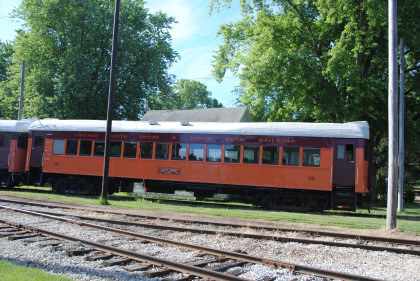
Chicago South Shore and South Bend coach 39 built by Standard Steel in 1929.
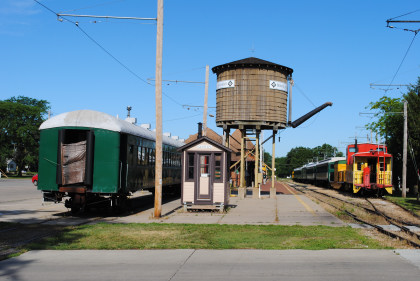
A Boone and Scenic Valley Railroad scene.
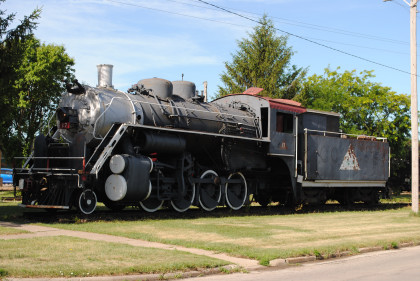
Crab Orchard and Egyptian 2-8-0 17, ex. John Thompson Monee, Illinois 1975, nee Roberval and Saguenay 17 built by Canadian Locomotive Comopany in 1940. It was one of the last steam engines built in North America other than for military use, and one of the last used in revenue service in the United States. The Roberval and Saguenay had its beginnings with the incorporation in 1908 of the Ha! Ha! Bay Railway to build from Jonquieres to Bagotville on Ha! Ha! Bay, Quebec, with branches to Chicoutimi Pulp Company mills, to Lake Kenogami and St. Alexis.
The Roberval & Saquenay itself was incorporated in Quebec in 1911 to build from Roberval on the Quebec & Lake St. John Railway around Lake St. John to rejoin the Q&LSJ at Chicoutimi and also at St. Bruno via a branch. It bought the Ha! Ha! Bay in June 1914. The steam engine worked on the R&S until retired in 1970, after which a tourist line, the Crab Orchard & Egyptian in Marion, Illinois then bought it in 1975.
Apparently, before the CO&E's shop crew had a chance to prepare the locomotive for passenger service, a depot fire in 1977 led to a decision to operate as a freight-only line. Seeing an opportunity offered by the newly arrived 2-8-0 in the yard, the CO&E restored it to service without its superheater or feedwater heater. It was originally equipped with a winterised cab and stoker, which were also removed by the CO&E. Its headlight was from a former Illinois Central electric trailer car.
17 made its last scheduled trip on 8th September 1986. In 1987, it was sold to the Boone and Scenic Valley and has since had its jacket, insulation, grates, turbo generator, bell, piping and cab appliances removed and placed in storage.
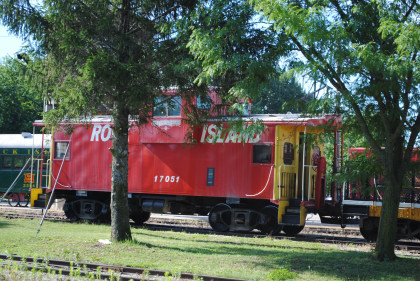
Chicago, Rock Island and Pacific caboose 17051 built by International Car in 1964.
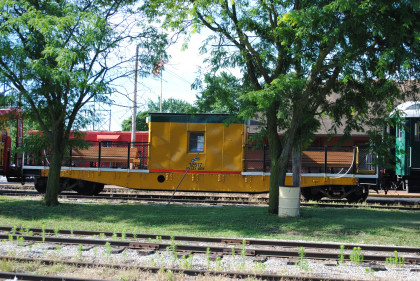
Chicago and North Western transfer caboose 12517 built by the railroad in 1964 and currently named "Valley View".
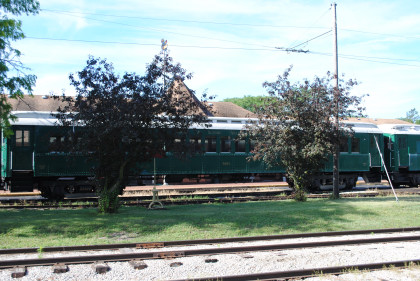
Boone and Scenic Valley concession car 9101, ex. Erie-Lackawanna 3219, exx. Delaware, Lackawanna and Western multiple unit trailer 2219, nee Delaware, Lackawanna and Western coach 319 built by Pullman in 1925.
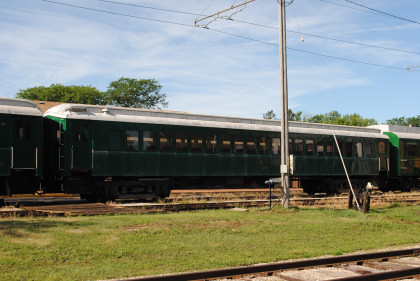
Boone and Scenic Valley coach 3238, ex. Erie-Lackawanna 3238, exx. Delaware, Lackawanna and Western multiple unit trail 2238, nee Delaware, Lackawanna and Western coach 338 built by Pullman in 1925.
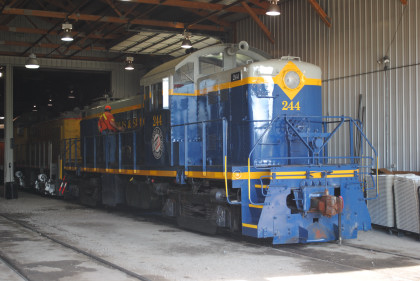
Boone and Scenic Valley RS-1 244, ex. Continental Grain in Pickering, Iowa, exx. Calumet and Hecla Railroad 205 1967, nee Lake Superior & Ishpeming 1002 built by American Locomotive Company in 1951. In 1996, it was donated to the Iowa Railroad Historical Society and is currently painted in Minneapolis & St. Louis Railroad blue.
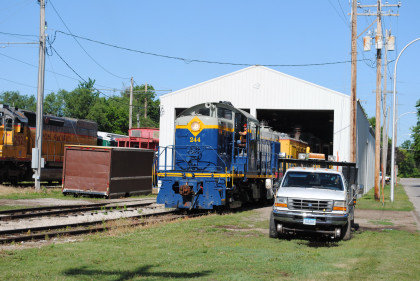
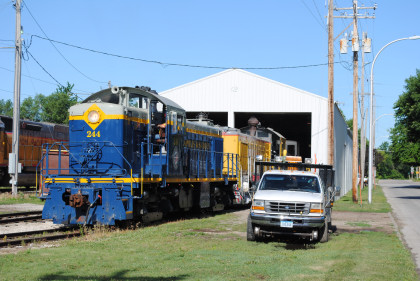
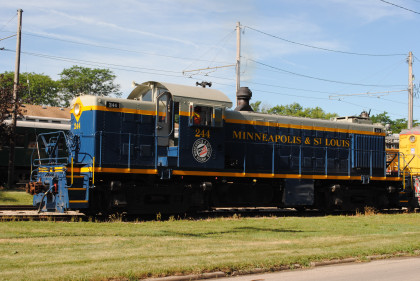
The 244 pulled two other engines out of the engine house on to the display track.
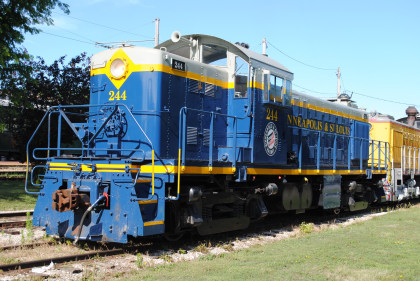
Minneapolis & St. Louis Railroad RS-1 244.
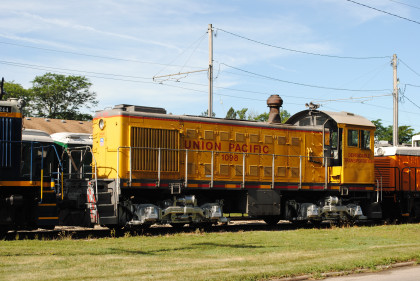
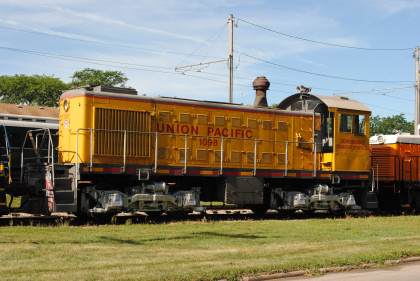
Union Pacific S-2 1098, exx. Archer Daniels Midland, ex. RELCO 1031, nee Terminal Railroad Association of St. Louis 575, built by American Locomotive Company in 1942. In 1997, 1031 was donated to the Iowa Railroad Historical Society by ADM. The Union Pacific Railroad was instrumental in moving the locomotive to Boone. Therefore, when the time came to repaint the locomotive, it was painted into Union Pacific's well-known colors. In October 1998, the locomotive emerged from the Boone & Scenic Valley Railroad's shops as Union Pacific 1098. That number is significant in that it signifies the date the locomotive was returned to service. Even though the locomotive never belonged to the Union Pacific, the number 1098 also fits into the series of numbers the Union Pacific did use for that particular model.
Fort Dodge, Des Moines and Southern 80 ton switcher 2254, nee United States Air Force 7858 built by General Electric in 1942. In 1983, the Air Force deemed the locomotive as surplus, and it was purchased by the Boone & Scenic Valley Railroad. The unit was a "good fit" for our railroad as the Fort Dodge, Des Moines and Southern Railroad, one of our predecessors, owned and operated very similar locomotives in the 1950's and 1960's.
In 1984, the unit was repainted, and renumbered 2254. 2254 was the number of people who came together in 1983 and purchased charter memberships in the Boone & Scenic Valley Railroad, saving this eleven mile section of trackage from abandonment and dismantling.
Union Pacific SD40T-2 2921, ex. Union Pacific 4476, nee Southern Pacific 8385 built by Electro-Motive in 1979. Three hundred and twelve of these units were built by EMD between 1974 and 1980. The major differences from a standard SD40-2 were the low radiator intakes and radiator fan grills located at the rear of the locomotive. These allowed more fresh, cool air to enter and fewer hot exhaust fumes to linger in tunnels. The SP 8300 series also featured extended noses for radio control equipment and were therefore referred to as "snoots" and "alligators".
It was retired in 2008, by which time the unit had run up over 2.5 million road miles and in February 2010, Union Pacific donated the locomotive to the museum.
Boone & Scenic Valley NW-2 1003, ex. Chicago and North Western 1003, nee Grand Trunk Western 7914 built by Electro-Motive Division in 1942. It was retired in the early 1970's, was sold to Precision National Corporation, rebuilt and sold to the Chicago & North Western in 1973. In March 1986, it was bought by the museum.
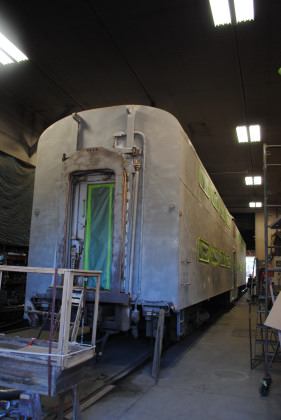
Chicago and North Western bi-level coach 96 was being repainted.
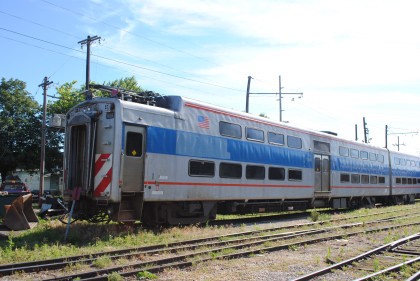
Metra Electric Highliner gallery coach 1506, nee Illinois Central 1506, built by St. Louis Car Company in 1971.
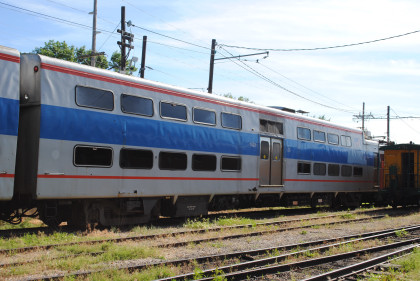
Metra Electric Highliner gallery coach 1523, nee Illinois Central 1523, built by St. Louis Car Company in 1971.
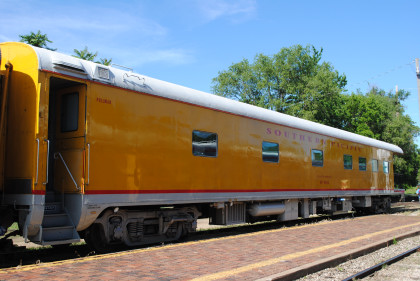
Southern Pacific 10-6 sleeper 9044 "City of San Francisco" built by Pullman Standard in 1950 and rebuilt with a large observation platform.
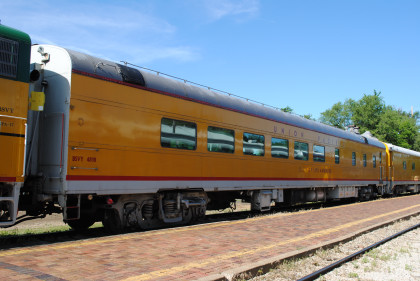
Union Pacific dining car 4810 "City of Los Angeles" built by American Car and Foundry in 1949.
Boone and Scenic Valley FP9A 6540, ex. Northeastern Kansas Railroad Museum 6540 2002, exx. VIA Rail 6540, nee Canadian National 6540, built by General Motors Diesel in 1958. It was retired in 1991 and purchased by the railroad in 2002. They painted it in a scheme similar to the Chicago & North Western and use to power the railroad's dinner, dessert and picnic trains.
Our Train SetBoone and Scenic Valley 2-8-2 JS8419 built by Datong in 1989. The JS was a product of co-operation between China and the USSR in the 1950's. The rolling chassis of the successful JF class Mikado was improved and paired with a new boiler based on a Soviet design to produce a mixed traffic locomotive. It went into production at Dalian in 1957 and at Qishuyan, Datong and Beijing in later years. The JS worked all over the China Rail network until the end of steam. Many of the 1980's engines then went into industrial service, and a considerable number were still operating at the turn of the century.
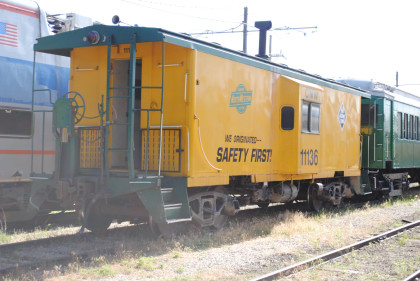
Chicago and North Western caboose 11136 built by International Car in 1966.
Boone and Scenic Valley coach 3207, ex. Erie-Lackawanna 3207, exx. Delaware, Lackawanna and Western multiple unit trailer 2207, nee Delaware, Lackawanna and Western coach 307 built by Pullman in 1925.
Boone and Scenic Valley coach 3218, ex. Erie-Lackawanna 3218, exx. Delaware, Lackawanna and Western multiple unit trailer 2218, nee Delaware, Lackawanna and Western coach 318 built by Pullman in 1925.
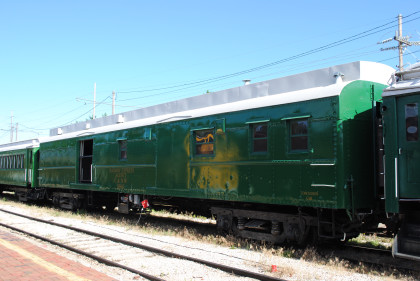
Boone and Scenic Valley concession 8646, nee Chicago and North Western baggage car.
Boone and Scenic Valley coach 3238, ex. Erie-Lackawanna 3238, exx. Delaware, Lackawanna and Western multiple unit trailer 2238, nee Delaware, Lackawanna and Western coach 338 built by Pullman in 1925.
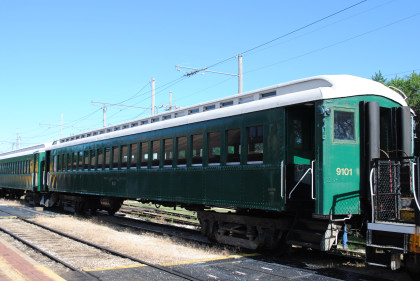
Boone and Scenic Valley coach 9101, ex. Erie-Lackawanna 3219, exx. Delaware, Lackawanna and Western multiple unit trailer 2219, nee Delaware, Lackawanna and Western coach 319 built by Pullman in 1925.
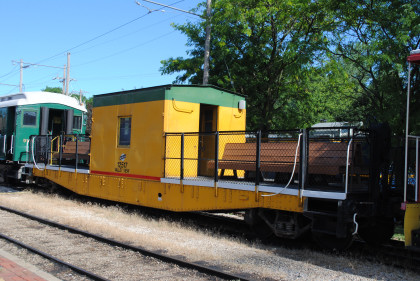
Chicago and North Western transfer caboose 12517.
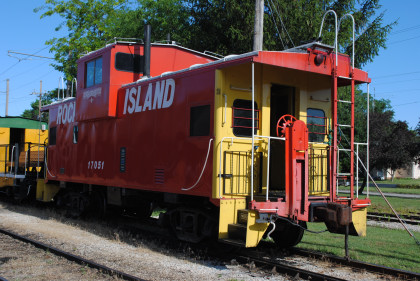
Rock Island caboose 17051.
Next I continued to explore.
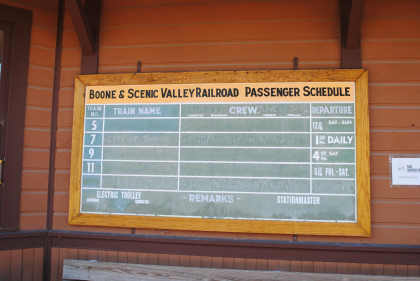
The timetable board at the Boone station after which I helped direct the buses to the parking lot.
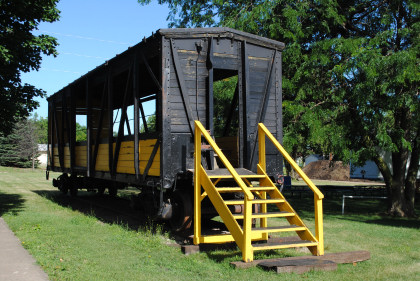
The old open car now used as a display car. I walked down to set up for the steam engine's arrival.
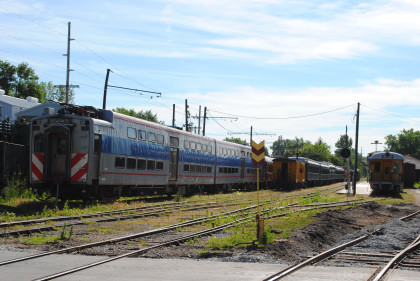
A view of the Boone station area.
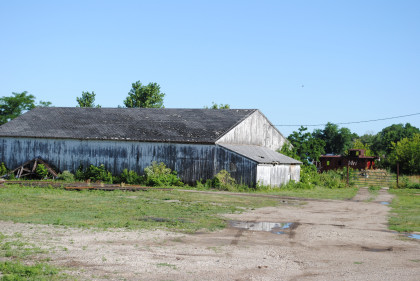
A Norfolk and Western caboose out in the storage yard.
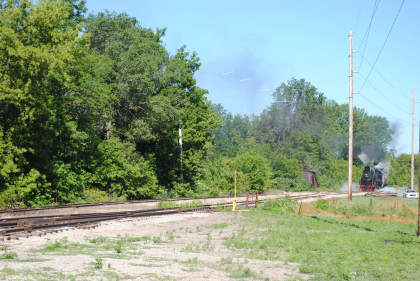
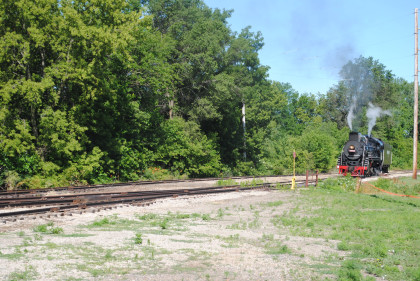
The steam engine pulled forward but then stopped.
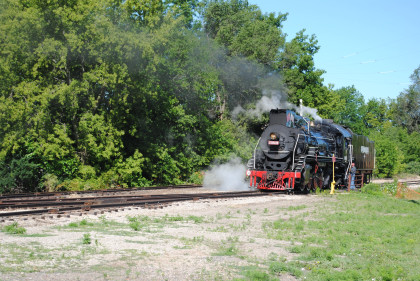
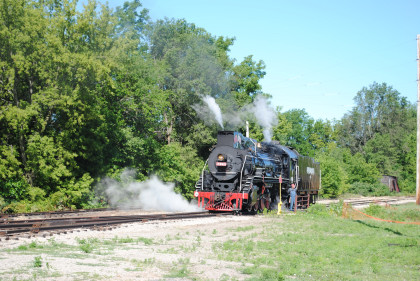
The ash pan was cleaned out. I was then driven over to the storage yard for some picture taking.
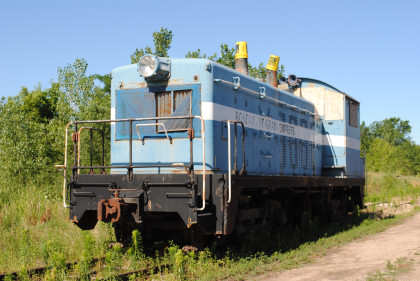
Bondurant Grain Express NW2 5202, nee Chesapeake and Ohio 5202, built by Electro-Motive Division in 1949, and acquired by the museum in 1991.
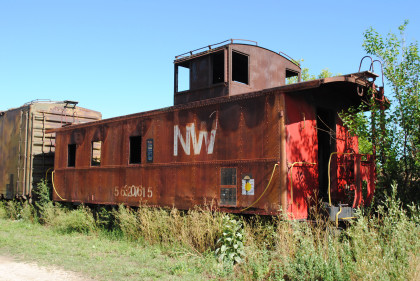
Des Moines Union Railway caboose 306, nee Norfolk and Western caboose 562715. The Des Moines Union Railway was incorporated in 1886 as a jointly-owned union railroad between the Wabash St. Louis and Pacific Railroad, which reached Des Moines in 1882; and the Chicago, Milwaukee St. Paul & Pacific which also reached Des Moines in 1882.
It was owned 50/50 between the two railroads. Along with serving the Wabash and Milwaukee Road, it would later serve the Chicago, Burlington and Quincy along with the Chicago Great Western. The line started at the huge junction near the capitol, where two Chicago, Rock Island and Pacific lines, the Wabash line, a Chicago Great Western line, a Chicago Burlington and Quincy, as well as a Minneapolis & St. Louis, line crossed. It would then follow the Rock Island line west.
It crossed the Des Moines River just upstream from the Rock Island, went through downtown and entered a large yard area, where it could interchange with the CB&Q, M&STL, Milwaukee Road as well as the Rock Island. The Milwaukee Road and Rock Island left this yard, going west. There was a spur from this yard to the Chicago Great Western Bell Ave Yard. It had to cross the Raccoon River. Ideally this was a highly successful railroad. And it was, throughout the first half of the 20th century.
The Wabash Railroad was swallowed up by the Norfolk and Western Railway on October 16th 1964. The N&W technically was leasing the Wabash. The Wabash was fully destroyed in the fall of 1991, when the N&W purchased the railroad outright.
Although the N&W and the Southern Railroad had affiliations since 1982, they were completely merged in 1997, forming Norfolk Southern. The N&W had complete control of the DMU since 1985, when the Milwaukee Road was having problems of their own. The Milwaukee Road sold off their line into Des Moines in 1983 to the Chicago and North Western, which later sold it to the Iowa Interstate Railroad, who had purchased much of the Rock Island line across Iowa from Council Bluffs to Rock Island in 1984.
They sold off their half of the Des Moines Union Railway to Norfolk Western in 1985. Both the CB&Q and M&STL lines over the Des Moines River were removed in the 1970's. When the Norfolk Southern was created, much of the DMU tracks were abandoned. The bridge over the Des Moines River was specifically abandoned. Today, while the DMU still exists on paper, most of the trackage is now gone. Portions are now a trail, including the large bridge across the Des Moines River.
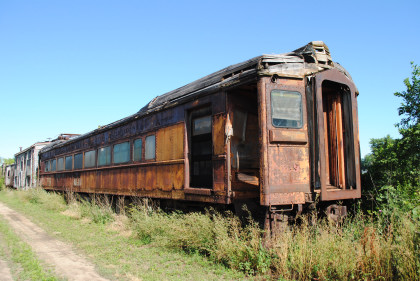
Chicago South Shore & South Bend combine 109 built by Pullman in 1926.
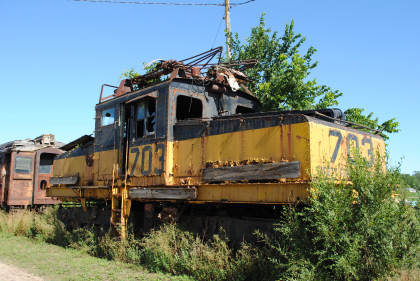
Kennecott Copper steeple cab 85 ton switcher 703 built by General Electric in 1928 and retired in 1983. It and another were donatd to Boone and Scenic Valley Valley Historical Society in November 1985 and delivered in June 1986. Both were acquired due to their similarity to Fort Dodge, Des Moines & Southern 209.
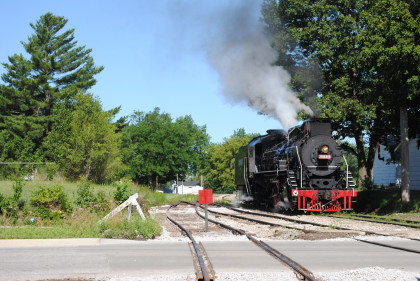
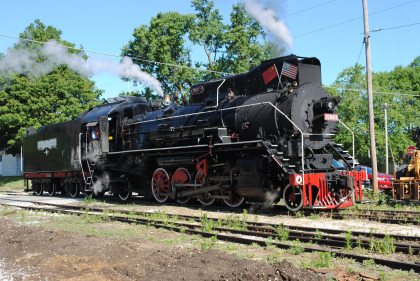
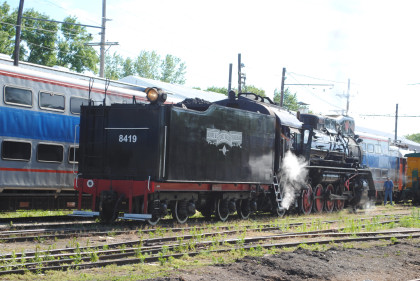
Boone and Scenic Valley 2-8-2 JS8419 arrived at the station.
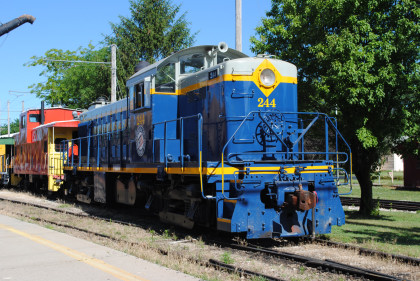
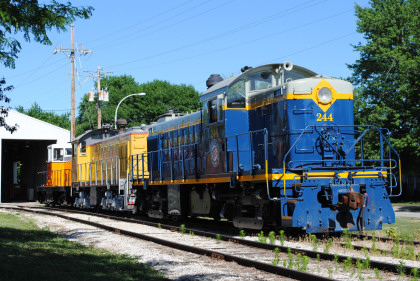
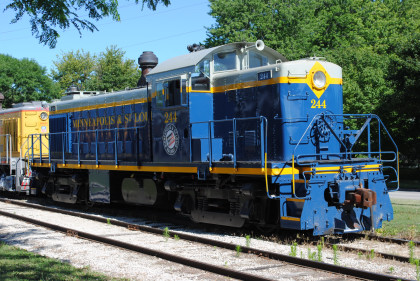
Minneapolis & St. Louis Railroad RS-1 244 then moved back to the display track.
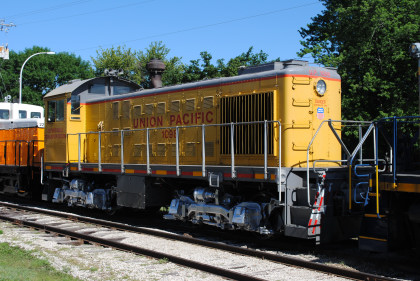
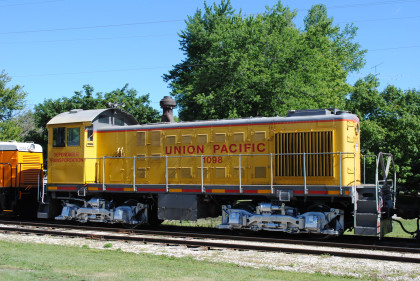
Union Pacific S-4 1098.
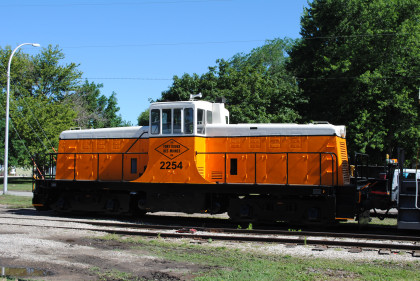
Fort Dodge & Des Moines 2254.
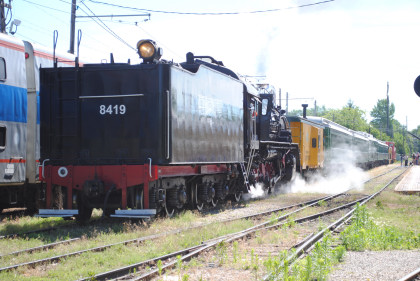
Our train was almost ready for boarding.
BSVR 2-8-2 JS8419.
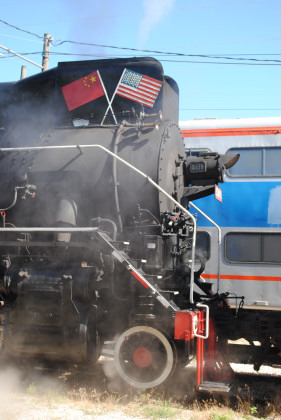
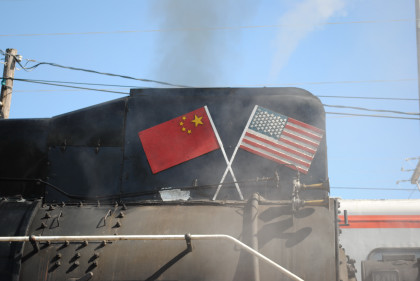
The Chinese and American flags on the steam engine.